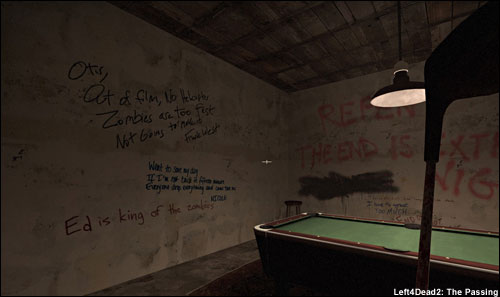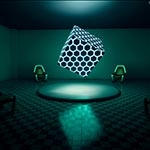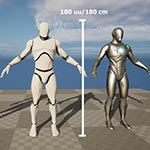World of Level Design™
Tutorials to Becoming the Best Level Designer and Game Environment Artist (since 2008)
Following article was written and contributed by Sylvain Douce 'Channie'
LEVEL DESIGN AS STORYTELLING

The last conference of the day was led by Joel Burgess. Entitled "Level Design as Storytelling", it was about the tools we have at our disposal to tell stories, regardless of their size or depth, directly into our levels.
The first step, as Joel puts it, is to admitting we're all novices: we don't know yet how little we know! The Level Designer has a very special relationship with the player: he's kind of driving the coach where the player is seated during the game journey. So we definitely can let the player enjoy some sightseeing as we drive.
As level designers, we can use various storytelling tools and techniques. For instance, we shouldn't hesitate to pick here and there from literature and cinema.
There are two kinds of tools we can use:
- Language (speech, text, spraypaint, ...)
- Visuals (layout, FX, clutter, ...).
Why language? Because it's familiar, direct and clear. But there are traps, like tired techniques (i.e. unskippable lenghty paragraphs of scrolling star wars text :) or localization concerns (slang translation is VERY hazardous). You will have to take a step back and define what is the most important to say, in the most concise way. Not every player reads, especially when the text is lenghty.
On the localization side, Joel told us two stories about his experience at Bethesda. On the German version of Fallout 3, a nice text effect was lost around the translation of an English slang term. On Oblivion, the translation of "stinky dick" in Spanish was meaning something completely different! Joel told us since we're not involved in the localization process, we have to be very careful of the terms we use. We have to talk with the fewest words possible without "dumbing down" the audience but..."vigorous writing is concise!"
Try not to do the part the reader wants to skip, and if you really want to do this part, try to find alternate ways to do so. The best practices are: concision and content quality. Remember that any gameplay information must come first! Speak in the language of the game world!
Static texts are optional and skippable! Joel took Left 4 Dead as a perfect LD storytelling example, showing the safe rooms texts written on the walls. The player is not forced to read, the writing is concise, the writing is spoken by the game world (fictional citizen), it conveys gameplay information. Joel displayed additional examples as of Bioshock and Fallout 3, showcasing dialogue during action, letting the player to be entertained on different levels.

The best practices are: concision and content quality. Remember that any gameplay information must come first! Speak in the language of the game world!
Visual Storytelling. Visuals are older than language, cavemen were drawing stories in their homes way before writing was invented! Moving to Renaissance (Venus from Botticelli), to modern days (Guernica from Picasso, and photographs), Joel demonstrated that every piece of art tells stories, and they're just as powerful as writing!
We have a huge array of visual tools at our disposal:
- Level Layout
- Lighting (it acts over the human psyche)
- AI behaviour
- Small clutter
- Particle FXs
- State changes
- Post Process
To make the best use of those tools, we must understand a bit how the human brain works. That's what Gestlat is about. To bastardize the concept, Gestalt is about the human cognition and especially its ability to do pattern recognition. Joel showed us a famous picture of a glass forged from 2 human faces.

Whether we first saw the faces or the glass doesn't matter. What mattered was the fact our brain did compute the image to extract a meaning. Our brain is hard wired to draw conclusions: we crave order in what we see! Familiar shapes are the most recognizable. Nowadays, there are a lot of gamer demographics, and it's still growing! We can easily be lost, but since we're all humans, we can use gestalt.
Joel tells us another example: "I have done a whitebox. It is faily abstract. But as soon as I add brick textures, your brain is going to narrow down and deduce the corresponding environment! If I drop characters or clutter, or any prop...we can't help but draw conclusions..."
Environments always tell stories, even if it's just a theme, so you might just take advantage at it! So you should collaborate with your artists! Open it up and make it a two-way stream: feed you peer with what kind of story you want to tell and let him do the same. Educate and involve, enable your team to contribute.
At Bethesda, Joel had only 6 LDs and 4 artists, that wasn't a lot so they HAD to do it, to increase the richness of the game. As a side note, Joel did meet with several past modmakers, and they didn't want to lose ownership. Well ownership is still a good thing, but you still need to collaborate and step the ownership away... Be helped on your level! All required is oversight.
Joel told us that Valve's Chet Faliszek could have written all the L4D safe rooms texts but instead, he did send an e-mail to very valve employee asking for suggestions! It motivates the team because you involve them and let them know what your goals are. They will like it eventually, and understand how to make your level better, and they will better help you nailing it!

Joel takes now a new example, called Snapshot Story. It's a picture of a grave. Kind of boring as is. Just add something on top of it (like a piece of clutter), and it starts to tell a story (i.e. Joel adds a Teddy Bear and now we draw conclusion as this pictures the death of a child). It's simple as that: just combine the visuals to create the story!
Now Joel shows us how to put this together, by taking example a little sequence from Fallout 3: The Radio Tower message
The CB Radio looping the same message begins to tell a story. Radio static is our gameplay clue. The story is then snapshoted through the skeleton models, the children toys, the shells and all the remaining clutter. The gestalt arrives when the player turns off the radio transmitter...He's part of the storytelling process!
Interactivity is what distinguish us from the rest. To exploit it, we must accept chaos, because we are not traditional storytellers! Joel makes a last example: You are asked to picture a beautiful Phoenix. Do you create it with oil painting or with dominos? Let the viewer knock the dominos off! Setting up a phoenix with dominos is not nearly as beautiful as an oil painting, but what is important is the interaction with the viewer. You did that, you made them fall, you were part of it... It makes you UNIQUE!
As final words: Let the player own the story, leave gaps, don't demystify! (In Fallout 3 they deliberately removed some info related to Rivet City to keep it open). The story doesn't have to be perfect, because you can still build another stories, but anyway, players stories will always be better than others, because the player will have the ownership of it.
GDC 2010 Level Design Notes Part 1 by Sylvain Douce
GDC 2010 Level Design Notes Part 2 by Sylvain Douce
GDC 2010 Level Design Notes Part 3 by Sylvain Douce
Home Terms of Use/Trademarks/Disclaimers Privacy Policy Donate About Contact
All content on this website is copyrighted ©2008-2024 World of Level Design LLC. All rights reserved.
Duplication and distribution is illegal and strictly prohibited.
World of Level Design LLC is an independent company. World of Level Design website, its tutorials and products are not endorsed, sponsored or approved by any mentioned companies on this website in any way. All content is based on my own personal experimentation, experience and opinion. World of Level Design™ and 11 Day Level Design™ are trademarks of AlexG.
Template powered by w3.css


 UE5: How to Download and Install Unreal Engine 5 in 5 Minutes
UE5: How to Download and Install Unreal Engine 5 in 5 Minutes UE5: 11 Principles to Learning and Using UE5 as a Complete Beginner
UE5: 11 Principles to Learning and Using UE5 as a Complete Beginner UE5: Crash Course Quick-Start Guide to Begin Using UE5 - TODAY
UE5: Crash Course Quick-Start Guide to Begin Using UE5 - TODAY UE5: Complete Guide to Player Scale, Dimensions and Proportions
UE5: Complete Guide to Player Scale, Dimensions and Proportions UE5: Fundamentals Vol.1 - Essential Beginner's Guide to Getting Started
UE5: Fundamentals Vol.1 - Essential Beginner's Guide to Getting Started



